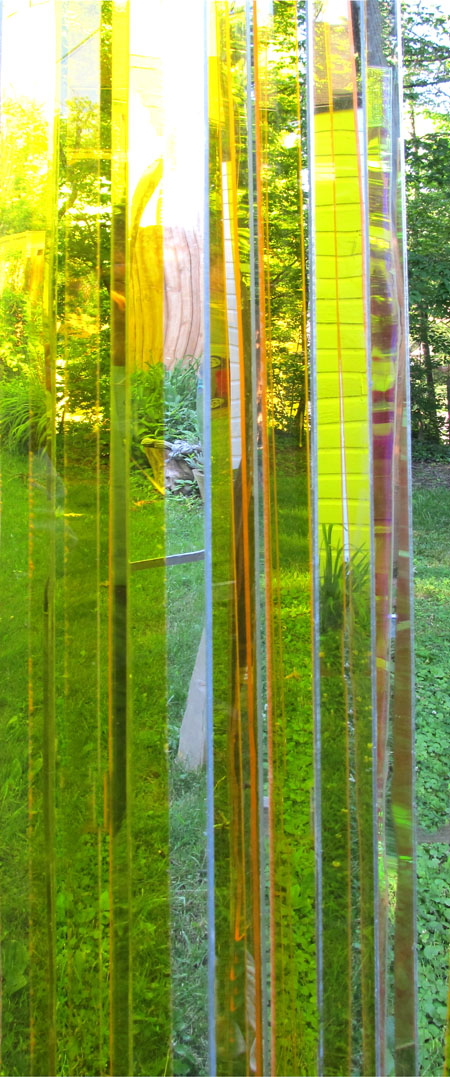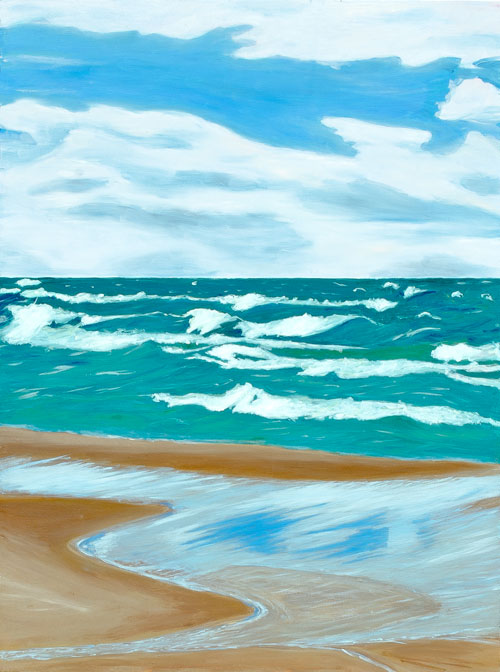Posted by Jay on January 21st, 2012
Nice weather, a substantial amount of basic material, a collection of experimental artifacts and a weed burner led to these objects. It boils down to the discovery that, sufficiently heated, acrylic plastic will deform and and fuse together, one item to another.

In this instance I had some acrylic cutouts for a project that wasn’t working out. I melted them together with the result that a draped effect emerged with an enrichment of colors and surfaces. Roughly three feet across.
more… »
Filed in Uncategorized
- Comments closed
Posted by Jay on November 11th, 2011
It seems that I am the only person who wants to use this utility. Allow me, then, to add a few more things that I have been working on.
One might refer to these items as baked goods as they represent the application of fire to one form or another of plastic. The first image began as a sheet of expanded polystyrene that was scored with a knife and scorched with a propane weed burner. This process opened the score lines and created checkered patterns which guided my application of paint and varnish.

more… »
Filed in Uncategorized
- Comments closed
Posted by Jay on August 3rd, 2011
I am trying this summer to simplify my productive activities without too much success.
I’m swimming in notions about how to create visual effects, whereas I should be advancing messages. The kit is there, now for more of a narrative.
On the one hand the chandeliers are happy being themselves: it’s the paint application technique that I’ve come up with that’s causing trouble. It produces results easily but, for now somewhat too randomly. I’m trying to harness it’s propensity for doing its own thing by finding things for it to do. Things that tend to be rendered in stone is one approach that I am playing with.

In this instance I have used black, white and green paint. The result I’m getting reminds me of sections of metamorphic rock. The technique is simple, but I’ll leave it to you to guess how it’s done.
more… »
Filed in Uncategorized
- Comments closed
Posted by Birgit Zipser on July 26th, 2011

Sandy edge, 18 inch x 18 inch, oil on birchwood panel
Vertical seems to be an ephemeral property. A sandy edge molded by ice and waves will soon crumble. The jaggedness of the Great Teton Mountains will be replaced by rounded shapes demonstrated by the juxtaposed older Gros Ventre Mountains.
In much of the cosmos, there is a wealth of curved lines – the planets with their elliptical motion, our double Helix and the curvatures of our spine.
Why then is verticality inspirational with gothic and current architecture reaching into the sky?
Filed in painting
- Comments closed
Posted by Birgit Zipser on July 14th, 2011

Birgit Zipser, watery fantasy, 11×14 inches, oil on panel
‘What I learned when I learned to draw’ by Adam Gopnick, The New Yorker, June 27th, discusses Jacob Collins‘ approach to drawing, which involves perceptual rather than conceptual viewing. The idea is to disengage from drawing symbols – conceptual schema of an arm or a face – and draw what you actually see. What you actually see may be a funny shape, a frog or an outline of a new African state, due to the play of light and shade on the body of the model. Thus, Gopnick was guided to learn to draw by ‘searching for strange shapes to break his symbol set’.
Jacob Collins in his “traditional realist revivalism” paints nudes, still lifes and landscapes. I may understand how the artist can draw a person modeling for him or cherries in a bowl by searching for shades and shapes rather than by using conceptual symbols. But doesn’t this approach break down when landscapes are drawn that contain water?
Water does not hold still for the slow musing approach to drawing that Adam Gopnick tells us Jacob Collins uses. My question is does Collins paint water using his symbol set of water?
Filed in art education
- Comments closed
Posted by Jay on June 30th, 2011
These are some pending objects.

I have been working on plastic chandeliers for the last while. This is a close up of one composed of clear yellow acrylic and mirrored rhombs. more… »
Filed in Uncategorized
- Comments closed
Posted by Birgit Zipser on June 24th, 2011

Blauer Fetzen, Birgit Zipser, oil on birch panel, 24 inches x 18 inches
The speakers of the last two talks at the Glen Arbor Art Association – Michael Letts on June 9, 2011 and Rachel Meginnes on June 23, 2011 – had things in common.
Both Michael Letts and Rachel Meginnes focus on geometrical patterns – Michael paints landscapes in abstract symbols and Rachel paints geometric shapes on cloth.
Both artists professed a zen-like attitude towards, what one may consider, tedious tasks. Michael paints ‘marks’ on his large geometrical sketches achieving a fabulous 3-D effect with shadows and highlights. Rachel, to generate the orthogonal grid underlying her painting, pulls threads out of fabric, usually cotton.
It was inspiring to listen to both discussing further development of their art – Michael Letts is experimenting with new motifs and Rachel Meginnes is developing a novel technology in fiber art.
Geometry and meditation are an ancient combination, an example are Mandalas, while the quest to developing new forms of art is an individual expression rather than one based on ancient belief systems.
Filed in art world
- Comments closed






